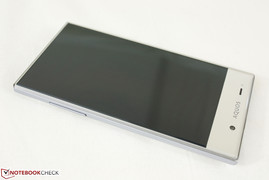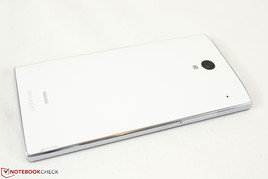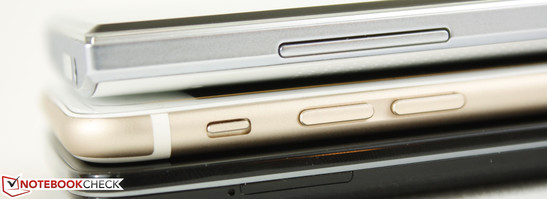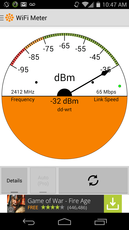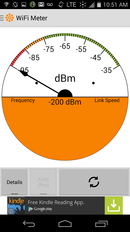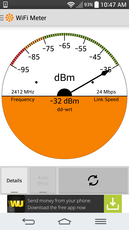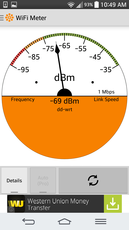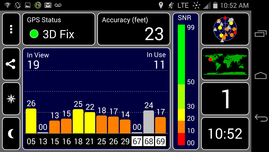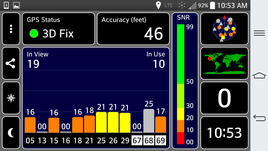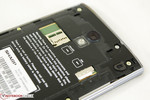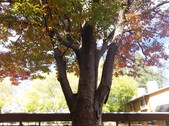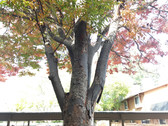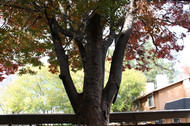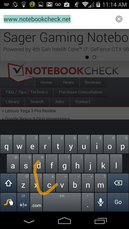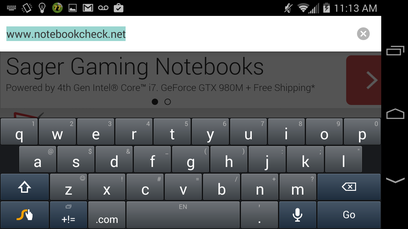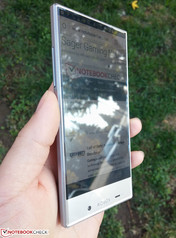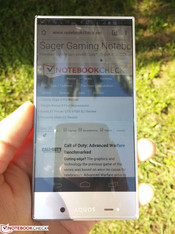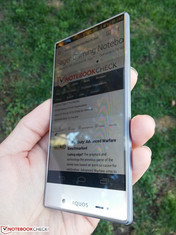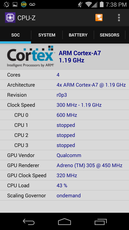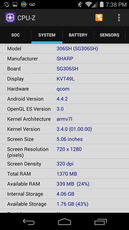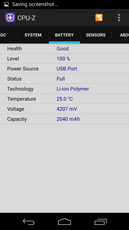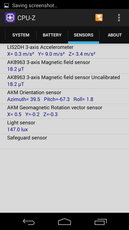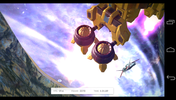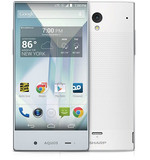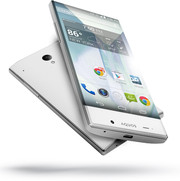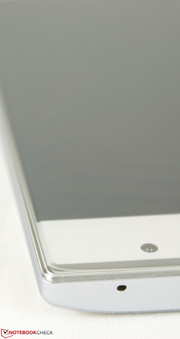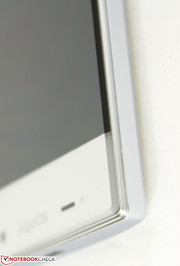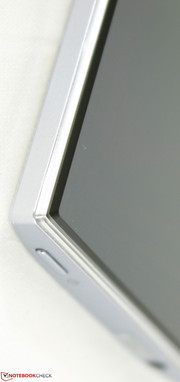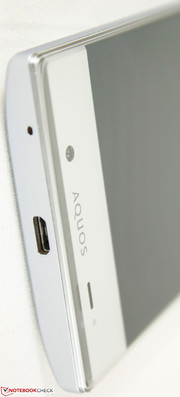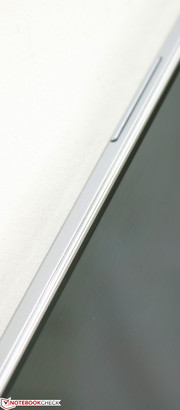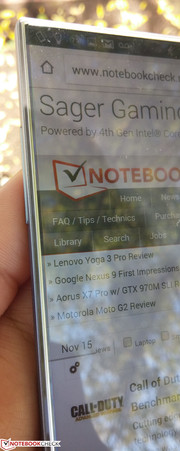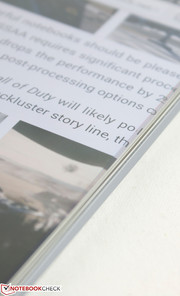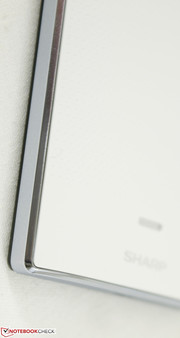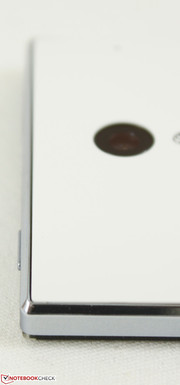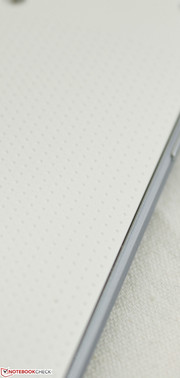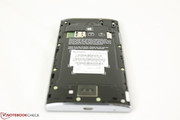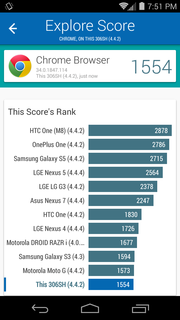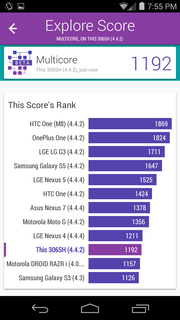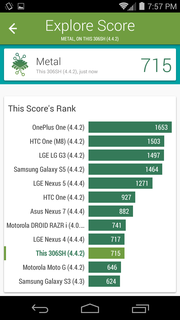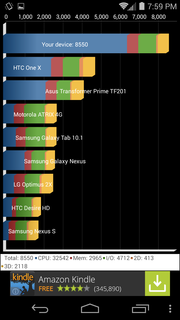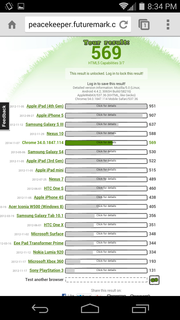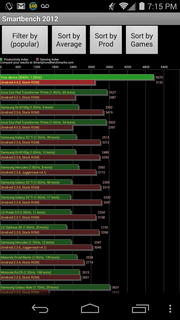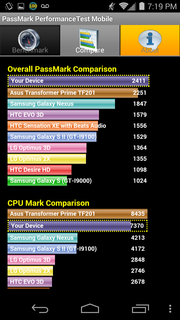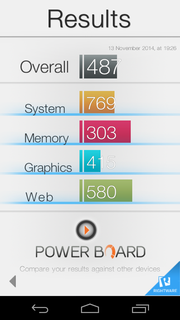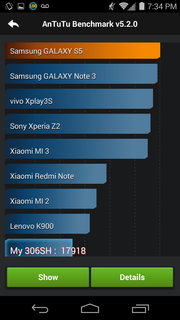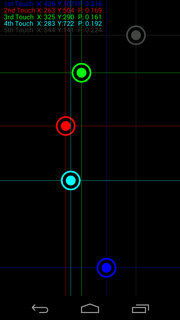Sharp Aquos Crystal Smartphone Review
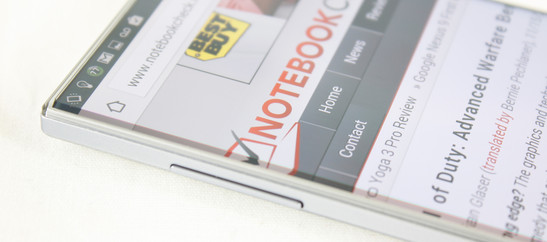
Sharp has been a household name in the U.S. since the early days of CRTs and it continues to be one of the largest manufacturers of LCD panels. Unlike competing corporations like Samsung and LG, however, Sharp is almost unknown for its smartphones in North America as the Japanese giant had never officially released a smartphone in the region - until now.
The Aquos Crystal is the first smartphone from Sharp to launch in the U.S., but this isn't the reason why it's making headlines. The nearly edge-less design is one of the most eye-catching features on a smartphone in recent years and its visual appeal is so atypical that the device was recently nominated as the 2015 CES Innovation Awards Honoree. The Crystal delivers an experience that is entirely unique to its design, and it retails for just $150 off-contract.
Internally and on paper, the 5-inch phone features basic hardware that is common amongst inexpensive and mainstream phones. This includes a 720p display, 1.5 GB RAM, and an entry-level Snapdragon 400 SoC. However, it also houses a few unique features including a vibrating display to produce sounds instead of a dedicated earpiece. A larger 5.5-inch model, called the Aquos Crystal X, is also available in its home country, though no U.S. launch date has been set. We take our Aquos Crystal for a full spin in this review to check out both its performance and novel hardware.
Case
The chassis itself is a spectacle. The Crystal's bezel-free design allows for a very high percentage of the front surface to be screen space and the sharp corners and edges around the device reflect its namesake well. The front glass is truly edge-to-edge with no plastic or metal material encompassing the perimeter and, when viewing from the sides of the Crystal, there is no other smartphone quite like it as the entire thickness of the front glass can be seen.
Nonetheless, this Sharp smartphone is still a budget device and it certainly feels more down-to-Earth than what its design would otherwise suggest. Aside from the glass front, the rest of the Crystal is plastic all-around from its chrome and silver edges to its removable flexible cover. This textured matte cover feels cheap and ordinary, especially compared to the distinct glossy front. As expected, the case is not Mil-Spec rated for dust or water resistance.
The Crystal holds up very well against twisting and bending, likely due to the overall thick edges and corners and display. Attempting to lightly bend the device results in no damage and no creaking. Unintentional gaps or crevices are also nonexistent on our test model.
As for size, this is likely one of the smallest 5-inch smartphones in the market because of its minimalistic frame. A quick comparison to other recent 5-inch devices like the Lumia 830, Google Nexus 5, and HTC One M8 shows that the Crystal is more than just a few square millimeters smaller in length and width. Its thickness, however, is much more standard at 10 mm, which is just 1 mm shy from the thicker Moto G2.
Connectivity
Aside from the standard micro-USB and 3.5 mm audio ports, the Crystal supports microSD cards on the rear of the unit. USB OTG is also supported as our generic keyboards and mice are able to connect successfully. Our connected external monitor, however, cannot be recognized since there is no support for MHL. Instead, Miracast is available in its place for compatible monitors.
Communication
WLAN includes integrated Bluetooth 4.0 and is compatible with 802.11b/g/n networks. Range is unfortunately lower than expected as the Crystal will drop its connection to a home wireless-n around 5 meters before our LG G2. Still, the range is satisfactory for typical indoor usage and environments and we experienced no unexpected drops or connectivity problems when connected to wireless networks.
The GPS locates and locks on to available satellites very quickly as the radio receives assistance from the carrier network. We faced no issues maintaining an accurate fix for driving purposes.
Telephone & Speech Quality
Unlike most unlocked smartphones out of Asia, the Aquos Crystal is compatible with CDMA 800/1900 MHz bands in addition to 2500 MHz for LTE. It is not officially compatible with GSM networks since the device is marketed towards Sprint and Boost Mobile customers in the U.S.. It does, however, support Wi-Fi calling, so calls can still be made without a SIM card or reliable carrier connection so long as the device is connected to a WLAN network or 3G service.
The earpiece is not a traditional speaker and is instead Sharp's "Direct Wave Receiver". Rather than using dedicated diaphragms to produce sound, the entire display vibrates in its place. Consequently, the user can place his or her ear anywhere on the display to listen without penalty to volume.
Does sound quality suffer? Unfortunately yes, and in two key areas. For one, callers from the other end have a slight static when speaking. It's minimal to be fair, but noticeable nonetheless. Secondly and perhaps more importantly, maximum volume is a little low. This is not a huge problem indoors, but the maximum setting is recommended when having a conversation outdoors. It does not take much ambient noise to overpower the "earpiece" of the Crystal.
Cameras & Multimedia
The included camera app features many options from the usual HDR and ISO settings (50 up to 1600) to anti-flicker (50 and 60 Hz) and anti-shake for videos. There are also overlays based on the rule of thirds and the golden ratio to aid in different types of photos from food to portrait shots.
Camera quality from the rear 8 MP camera is average at best under good lighting conditions. Typical indoor shots are rather poor and blurry, so snapshots are best done in a bright outdoor setting. The system autofocus has a tougher time working correctly when indoors as well. Exposure is slightly on the heavy side and pictures are muddier than expected from an 8 MP camera. Otherwise, we noticed no major issues with colors and only small amounts of purple fringing around hard edges like leaves.
Videos up to 1080p30 can be taken with the rear camera and are saved as 3GP files. Quality is smooth when panning or following moving objects slowly, but there is a large amount of noise that makes videos appear much less sharply than they should. Moderate to fast movement will cause unacceptable motion blur.
Playback of video files is smooth up to 1080p. The tested Big Buck Bunny files (MP4, MPEG4, H.264) are supported natively on the platform. Similarly, HD videos on YouTube play without any frame skips or stutters.
Warranty
The standard one-year warranty is available from various markets as Sharp does not sell the model directly to customers.
Input Devices
Touchscreen
The 5-finger capacitive touchscreen allows for quick, accurate, and responsive inputs as expected from any smartphone. The onscreen keyboard and the device in general will remain responsive with little latency even under moderate multitasking, which is something that can't be said for many other budget smartphones. Swype is included with the default keyboard alongside the usual predictive typing, spell checker, and other common features.
Note that unlike the standard Windows Phone 8.1 landscape keyboard where the sides are left empty, the standard Android keyboard stretches all the way to the edges. This does allow for bigger keys, but users with larger hands may find it more difficult to tap edge and corners keys like Q, P, or Delete reliably. This problem is more prevalent on the Aquos Crystal than on other Android devices because of the edge-less frame. Some keys can be so close to the palm as to make typing more uncomfortable than it should be despite the large 5-inch display. Coincidentally, accidental inputs around the edges are more likely. Users with smaller hands can adapt quickly, though users with larger hands may find typing on more "typical" 5-inch phones to be preferable.
Display
The near-borderless display is the star of the Aquos Crystal. Its paper specifications are somewhat insipid and not all that different from competing budget 5-inch smartphones, but the one-of-a-kind display makes the Crystal so much more fun to use in comparison. Onscreen videos pop in a way that other smartphones can only dream of. Text and colors are bright and sharp as well, though admittedly not as sharp as phones with FullHD screens. A 1080p model would have likely had a large impact on performance and price due to the entry-level SoC in the device.
Display brightness averages a little over 400 nits across nine quadrants of the screen. This is brighter than the recently released Moto G2 and is on par with the Lumia 830, LG L Bello, and even the more expensive LG G3. Sony's crown jewel - the Xperia Z3 - still takes the cake with a brightness of nearly 700 nits and a contrast that is twice as deep, but the Sharp is still more than satisfactory for pictures and video playback with no significantly crushed blacks or muddy grays.
Note that because of the thick glass front and lack of an opaque bezel, light will refract from the sharply angled edges and corners of the display. This has a neat visual effect around the edges of the screen (see right image) that is not present on any other phone, but it is understandable that some users may find this to be a slight nuisance.
| |||||||||||||||||||||||||
Brightness Distribution: 93 %
Center on Battery: 401.6 cd/m²
Contrast: 558:1 (Black: 0.72 cd/m²)
ΔE ColorChecker Calman: 3.63 | ∀{0.5-29.43 Ø4.78}
ΔE Greyscale Calman: 2.84 | ∀{0.09-98 Ø5}
Gamma: 2.16
CCT: 6658 K
| Sharp Aquos Crystal Adreno 305, 400 MSM8926, 8 GB SSD | LG L Bello Mali-400 MP, MT6582, 8 GB SSD | Google Nexus 5 Adreno 330, 800 MSM8974, 16 GB iNAND Flash | Nokia Lumia 830 Adreno 305, 400 MSM8926, 16 GB eMMC Flash | Sony Xperia Z3 Adreno 330, 801 MSM8974AC, 16 GB eMMC Flash | |
|---|---|---|---|---|---|
| Screen | -14% | 32% | 5% | -25% | |
| Brightness middle (cd/m²) | 401.6 | 421 5% | 469 17% | 440 10% | 702 75% |
| Brightness (cd/m²) | 410 | 411 0% | 452 10% | 421 3% | 671 64% |
| Brightness Distribution (%) | 93 | 94 1% | 94 1% | 87 -6% | 90 -3% |
| Black Level * (cd/m²) | 0.72 | 0.5 31% | 0.49 32% | 0.77 -7% | 0.72 -0% |
| Contrast (:1) | 558 | 842 51% | 957 72% | 571 2% | 975 75% |
| Colorchecker dE 2000 * | 3.63 | 6.75 -86% | 2.05 44% | 2.6 28% | 8.92 -146% |
| Greyscale dE 2000 * | 2.84 | 5.63 -98% | 1.45 49% | 2.64 7% | 9.59 -238% |
| Gamma | 2.16 102% | 2.12 104% | 2 110% | 2.32 95% | 2.75 80% |
| CCT | 6658 98% | 7472 87% | 6441 101% | 6686 97% | 9408 69% |
* ... smaller is better
Three color modes are available on the Crystal: Standard, Dynamic, and Natural. Our results below with an X-Rite spectrophotometer are based on the default Standard color mode.
In general, grayscale and certain colors (Green, Cyan, and Yellow) are reproduced very well across tested saturation levels. On the flip side, Red, Blue, and Magenta become increasingly inaccurate at higher saturation levels and RGB balance could have been better. Smartphones normally have more balanced DeltaE deviations across the tested saturation levels and colors, such as on the Moto G2 and LG G3, so it is a bit odd to see that Red and Blue perform as poorly as they do in on the Crystal in comparison. Regardless, these measurements have little impact on everyday use, especially on a smartphone.
Outdoor usability is quite good. The display surface appears to be more reflective than usual, so a high or maximum brightness setting is definitely recommended if under sunlight. Glare can be reduced by viewing straight on instead of from the sides where reflections can become more prominent.
Viewing angles are excellent due to the underlying IPS panel. The device can be used in both landscape and portrait modes without notable color distortions or other problems. Apparent brightness drops just slightly if viewing from wider angles. This is essentially a non-issue for the sole viewer.
Performance
The Aquos Crystal is equipped with a Snapdragon 400 MSM8926 SoC and integrated Adreno 305 graphics. This 1.2 GHz processor utilizes four Cortex-A7 cores as part of Qualcomm's entry-level family. Thus, it is commonly found on a number of budget and mainstream devices including the Zenfone 5, LG G2 Mini and Xperia M2. When idle or under low demands, three of the four cores are disabled with only one active at 300 - 600 MHz to conserve power.
Unlike most budget smartphones, the Crystal includes 1.5 GB of RAM, which is 512 MB more than expected. This should allow for better multi-tasking abilities and running background apps without as large of an impact on system responsiveness and overall performance.
Geekbench and LinPack scores put the Crystal a step behind the Nexus 5 and in the same ballpark as the LG L Bello. Flagship Androids with Snapdragon 800 series SoCs, such as the One M8, are at least 2 to 3 times faster than the Crystal in raw processor performance. More information and benchmarks on the Snapdragon 400 MSM8926 can be found on our dedicated page here.
| Geekbench 3 | |
| 32 Bit Multi-Core Score (sort by value) | |
| Sharp Aquos Crystal | |
| LG L Bello | |
| Google Nexus 5 | |
| Samsung Galaxy S4 GT-I9505 | |
| Huawei Ascend G730 | |
| HTC One M8 | |
| 32 Bit Single-Core Score (sort by value) | |
| Sharp Aquos Crystal | |
| LG L Bello | |
| Google Nexus 5 | |
| Samsung Galaxy S4 GT-I9505 | |
| Huawei Ascend G730 | |
| HTC One M8 | |
| AnTuTu v5 - Total Score (sort by value) | |
| Sharp Aquos Crystal | |
| Google Nexus 5 | |
| Quadrant Standard Edition 2.0 - --- (sort by value) | |
| Sharp Aquos Crystal | |
| Google Nexus 5 | |
| Samsung Galaxy S4 GT-I9505 | |
| Huawei Ascend G730 | |
| HTC One M8 | |
| Vellamo 3.x | |
| Metal (sort by value) | |
| Sharp Aquos Crystal | |
| Google Nexus 5 | |
| Multicore Beta (sort by value) | |
| Sharp Aquos Crystal | |
| Google Nexus 5 | |
| Browser (sort by value) | |
| Sharp Aquos Crystal | |
| Google Nexus 5 | |
System Performance
Subjectively, the Sharp Crystal is quick and responsive with minimal latency when scrolling and switching between applications. Basic commands like zooming are registered reliably and swiftly without issues. It's not as smooth or speedy as on more expensive devices and frame skips occur more frequently, but at the same time we experienced no crashes or memory limitations during everyday use.
Results from browser-based benchmarks below are very good for the Crystal compared to some older devices. It also trades blows with the Windows 8.1 Lumia 830 in certain tests like Sunspider and WebXPRT.
| Mozilla Kraken 1.1 - Total (sort by value) | |
| Sharp Aquos Crystal | |
| LG L Bello | |
| Google Nexus 5 | |
| Huawei Ascend G730 | |
| Nokia Lumia 830 | |
| HTC One M8 | |
| Google V8 Ver. 7 - Google V8 Ver. 7 Score (sort by value) | |
| Sharp Aquos Crystal | |
| Google Nexus 5 | |
| Samsung Galaxy S4 GT-I9505 | |
| Huawei Ascend G730 | |
| Nokia Lumia 830 | |
| Peacekeeper - --- (sort by value) | |
| Sharp Aquos Crystal | |
| Google Nexus 5 | |
| Samsung Galaxy S4 GT-I9505 | |
| Huawei Ascend G730 | |
| Nokia Lumia 830 | |
| HTC One M8 | |
| Browsermark | |
| 2.1 (sort by value) | |
| Sharp Aquos Crystal | |
| Google Nexus 5 | |
| Nokia Lumia 830 | |
| --- (sort by value) | |
| Google Nexus 5 | |
| Samsung Galaxy S4 GT-I9505 | |
| Huawei Ascend G730 | |
| HTC One M8 | |
* ... smaller is better
Storage Devices
Only 8 GB of storage space is included, nearly half of which is reserved for OS and system use. This leaves just 4.06 GB of free space for music, videos, apps, and other files. Fortunately, the microSD slot supports up to 128 GB, so the dimunitive internal storage is not a problem.
SSD performance according to AndroBench is very good compared to other top-tier brands like the Nexus and Galaxy, especially for a smartphone that retails for half the price or less.
Gaming Performance
By keeping display resolution to a native 720p, onscreen action puts less strain on the aging Adreno 305 graphics. Thus, nearly all games on the Play market are playable on the Crystal. Graphical benchmarks like Epic Citadel and 3DMark Ice Storm place the Crystal alongside other devices like the Xperia M2, Zenfone 5, and Galaxy Tab 4 10.1. Very recent and demanding titles like Asphalt 8 tend to stutter more often on the Sharp phone compared to playing the same title on the more powerful LG G2. Of course, 2D side-scrollers play without any such issues.
More information and benchmarks on the Adreno 305 can be found on our dedicated page here.
| 3DMark Ice Storm Standard Score | 5617 points | |
Help | ||
Emissions
Temperature
Idling surface temperatures are cool at under 30 degrees C on both sides of the device. Browsing the web for extended periods will keep the temperature profile flat without any significant rise or hot spots.
When under higher processing loads, the bottom half of the front surface warms up much more quickly than its top half, while the top half of the back surface warms up more quickly than its bottom half. It's a bit odd, but the temperature gradient is never extreme enough for the user's hand to become uncomfortable when holding the device. Much of the change in temperature occur towards the center of the device where users are less likely to hold. Our measurements below were taken after an hour long stress test with Stability Test 2.5, so most users will never experience surface temperatures even close to 38 degrees C. The LG G2 Mini with the same Snapdragon processor exhibit similar results. It is a low-power entry-level SoC, after all.
(+) The maximum temperature on the upper side is 38.4 °C / 101 F, compared to the average of 35.2 °C / 95 F, ranging from 21.9 to 247 °C for the class Smartphone.
(+) The bottom heats up to a maximum of 38.6 °C / 101 F, compared to the average of 34 °C / 93 F
(+) In idle usage, the average temperature for the upper side is 28.2 °C / 83 F, compared to the device average of 32.9 °C / 91 F.
Speakers
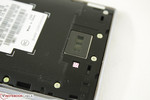
The speakerphone is located on the back of the device on the lower portion of the bottom half. Sound quality is acceptable with a loud maximum volume, though music and sounds seem a bit more high-pitched and hollow than usual due to the very low bass. The lack of adequate bass can be felt in songs with strong low frequency harmonies. In addition, the back of the device will vibrate a bit more aggressively than on other smartphones if volume is on a high setting.
An additional feature from harman/kardon is Clari-Fi and LiveStage audio. These post-processing effects are at its core pre-set equilizer options that Sharp claim will improve sound quality of MP3 files, which are typically heavily compressed. Subjectively, it is difficult to hear a significant difference in quality with Clari-Fi enabled, while LiveStage is equivalent to the "Large Hall" equilizer pre-set as it emphasizes echos and trails. While the effects and the visualizer overlay are neat, we ultimately would have much preferred a well-designed equilizer for even better manual control over our music.
Battery Life
The included 2040 mAh Li-ion battery is standard for a 5-inch phone. It is slightly smaller than the 2330 mAh and 2200 mAh battery packs on the Xperia M2 and Lumia 830, respectively. Unlike the latter Windows phone, however, the battery on the Crystal in non-removable despite the fact that the back cover can be removed.
Runtimes are good, but is only average compared to its competitors. The above Sony and Microsoft devices can last for at least 2 hours longer than the Sharp under the same WLAN conditions even though these devices use the same Snapdragon SoC. With that said, our estimated 8.5 hours of constant WLAN use should be sufficient for a good day of moderate activity.
| Sharp Aquos Crystal Adreno 305, 400 MSM8926, 8 GB SSD | LG L Bello Mali-400 MP, MT6582, 8 GB SSD | Google Nexus 5 Adreno 330, 800 MSM8974, 16 GB iNAND Flash | Samsung Galaxy S4 GT-I9505 Adreno 320, 600 APQ8064T, 16 GB iNAND Flash | Nokia Lumia 830 Adreno 305, 400 MSM8926, 16 GB eMMC Flash | |
|---|---|---|---|---|---|
| Battery runtime | 27% | 8% | 15% | 22% | |
| Reader / Idle (h) | 23.6 | 18.5 -22% | 27.4 16% | 30.1 28% | |
| WiFi (h) | 8.6 | 8.7 1% | 12.2 42% | 8.9 3% | 12 40% |
| Load (h) | 3 | 4.6 53% | 3.1 3% | 3.8 27% | 2.9 -3% |
Verdict
The display and design are the heart of any smartphone as they have a significant influence on user impression. This is what the Aquos Crystal does best since its avant-garde appearance is guaranteed to capture the attention of users who are out looking for a new or replacement model. The device becomes even more attractive once users find that its starting price is only $150 to $200 off-contract.
Despite Sharp's unique take on the bezel-free glass display, the Aquos Crystal is ultimately a budget phone. The chassis is plastic, camera quality is average at best, volume is low with static, and enthusiasts may be turned off by the entry-level Snapdragon 400 SoC, 720p display, and lack of both NFC and wireless-ac support. Look past its edge-to-edge screen and you will find a standard Android phone underneath.
Fortunately, the trimmed off features have no ill-effects on basic functionality. System performance and responsiveness are great for an inexpensive device and Wi-Fi calling is a very useful feature that is not as widespread as it should be.
U.S. users on GSM networks like AT&T are a bit out of luck for now, but the Aquos Crystal deserves at least a quick glance in person to appreciate its novel design philosophy. It looks fantastic, runs smoothly, and is cheap to boot. The small size also makes the Crystal a good fit for users who find 5-inch phones to be too big. We're certainly crossing our fingers for an international launch of the flagship 5.5-inch Aquos Crystal X to come sooner rather than later.




